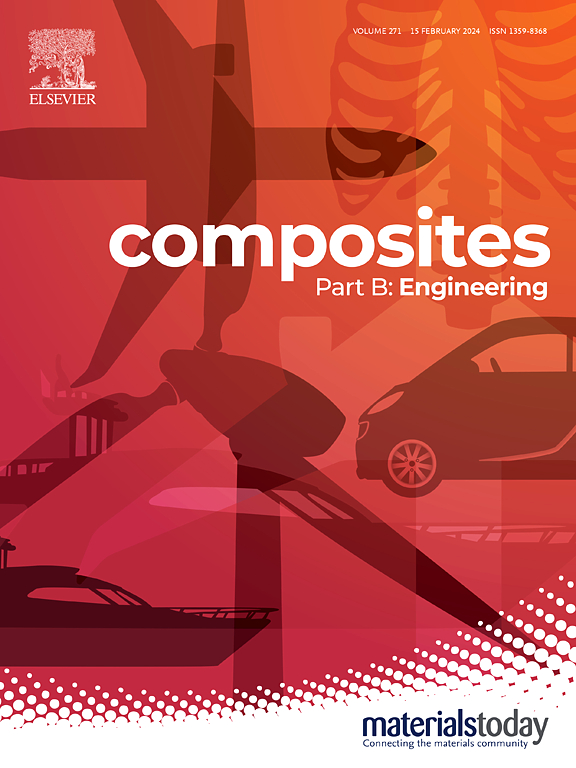High-velocity impact response of shear thickening fluid-filled sandwich lattice panels
IF 12.7
1区 材料科学
Q1 ENGINEERING, MULTIDISCIPLINARY
引用次数: 0
Abstract
This study investigates the impact response of sandwich panels with lattice truss cores (SPLTC), filled with shear-thickening fluids (STF), under various impact velocities using fluid-structure interaction (FSI) simulations. A constitutive model for STF, which accounts for bulk compressibility and nonlinear, strain-rate-dependent viscosity at high strain rates, is developed and validated through laser-shock experiments. The shock response of SPLTC with different fillers at impact velocities ranging from 50 to 200 m/s is analyzed using FSI simulations. The results show that STF-filled SPLTC (SPLTC-STF) significantly improves shock resistance and energy dissipation, absorbing 1.6 times more energy than the empty SPLTC. Additionally, the effect of STF thickening properties on the shock behavior of SPLTC-STF is analyzed, revealing that higher STF viscosity reduces deformation, enhances energy absorption, and increases buckling resistance. A two-stage energy dissipation process is identified, consisting of the shock wave attenuation stage and the FSI dissipation stage. While the specific energy absorption (SEA) increases with STF viscosity, it decreases beyond a critical viscosity threshold due to reduced fluidity and weaker FSI effects. These findings underscore the potential of SPLTC-STF for impact-protection applications and highlight the importance of optimizing STF parameters for maximum energy absorption.

剪切增厚充液夹层晶格板的高速冲击响应
采用流固耦合(FSI)模拟研究了填充剪切增稠流体(STF)的点阵桁架夹芯板(SPLTC)在不同冲击速度下的冲击响应。建立了STF的本构模型,该模型考虑了高应变率下的体压缩率和非线性、应变率相关的粘度,并通过激光冲击实验进行了验证。利用FSI模拟分析了不同填料的SPLTC在冲击速度50 ~ 200 m/s范围内的冲击响应。结果表明,填充stf后的SPLTC (SPLTC- stf)的抗冲击性能和能量消耗显著提高,吸收的能量是空SPLTC的1.6倍。此外,还分析了STF增稠性能对SPLTC-STF冲击性能的影响,发现更高的STF粘度可以减少变形,增强能量吸收,增加抗屈曲能力。确定了两阶段的能量耗散过程,即激波衰减阶段和FSI耗散阶段。虽然比能量吸收(SEA)随着STF粘度的增加而增加,但由于流动性降低和FSI效应减弱,SEA在临界粘度阈值之后会下降。这些发现强调了SPLTC-STF在冲击保护应用中的潜力,并强调了优化STF参数以获得最大能量吸收的重要性。
本文章由计算机程序翻译,如有差异,请以英文原文为准。
求助全文
约1分钟内获得全文
求助全文
来源期刊

Composites Part B: Engineering
工程技术-材料科学:复合
CiteScore
24.40
自引率
11.50%
发文量
784
审稿时长
21 days
期刊介绍:
Composites Part B: Engineering is a journal that publishes impactful research of high quality on composite materials. This research is supported by fundamental mechanics and materials science and engineering approaches. The targeted research can cover a wide range of length scales, ranging from nano to micro and meso, and even to the full product and structure level. The journal specifically focuses on engineering applications that involve high performance composites. These applications can range from low volume and high cost to high volume and low cost composite development.
The main goal of the journal is to provide a platform for the prompt publication of original and high quality research. The emphasis is on design, development, modeling, validation, and manufacturing of engineering details and concepts. The journal welcomes both basic research papers and proposals for review articles. Authors are encouraged to address challenges across various application areas. These areas include, but are not limited to, aerospace, automotive, and other surface transportation. The journal also covers energy-related applications, with a focus on renewable energy. Other application areas include infrastructure, off-shore and maritime projects, health care technology, and recreational products.
 求助内容:
求助内容: 应助结果提醒方式:
应助结果提醒方式:


